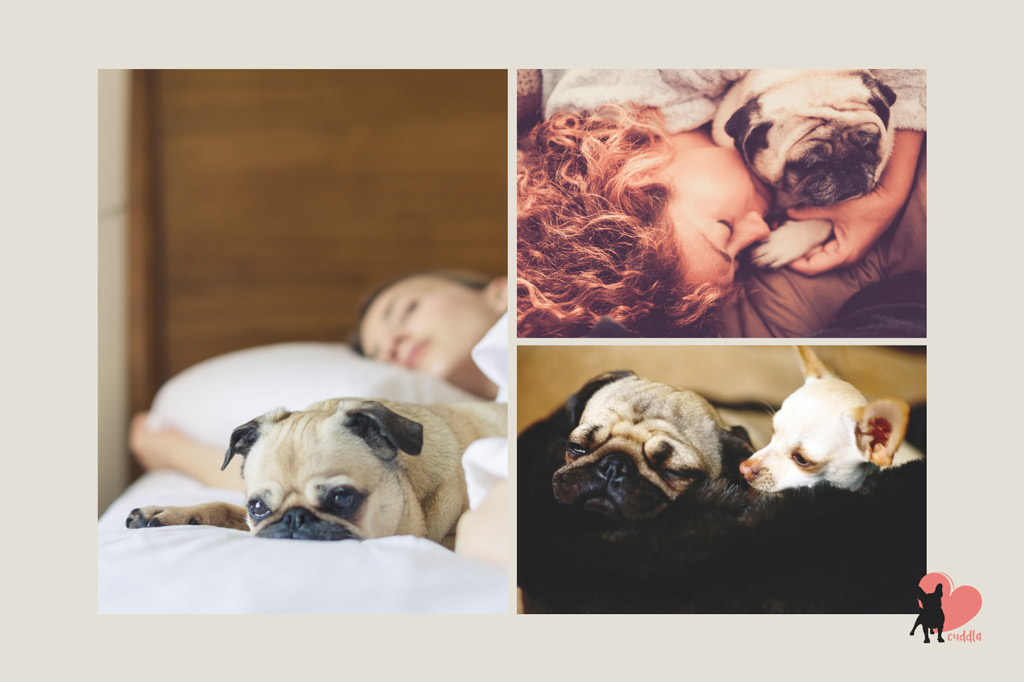
Pugs are known to be lazy, and also huge sleepers. But that’s not a given fact; it really depends on how you raise your dog. That being said, pugs do tend to enjoy their sleep and most times don’t mind where they fall asleep! But, how long do pugs sleep?
An adult Pug sleeps between 12 to 14 hours per day. Pug puppies and seniors, however, sleep 18 to 20 hours per day.
There are 5 factors that will influence Pugs sleeping habits (with some funny sleep illustrations ahead!) 🙂
How Long Do Pugs Sleep?
According to the National Sleep Foundation, an adult dog spends at least half of the day (between 12 to 14 hours) sleeping. However, puppies and senior dogs get even more sleep, around 18 to 20 hours.
That is the average. How much your Pug sleeps will depend on 5 factors:
- Age.
- Activity level.
- Diet.
- Breed size.
- Lifestyle.
These aspects will help you predict how much your pooch sleeps and if she’s at the higher or lower end of that range.
Before getting into each factor, here are some Pug sleep FAQs for you to get to know.
Pugs Sleeping Schedule
Dogs are flexible sleepers. Don’t expect your Pug sleeping 8 hours without waking up.
Unlike us, who rest best when we stick to a regular schedule, dogs are more flexible with their sleep. For instance, your Pug can easily wake up when there’s action:
- A knock on the door.
- Mail through the letterbox.
- When you get home.
- If they smell food, etc.
Basically, they jump to attention in a heartbeat!
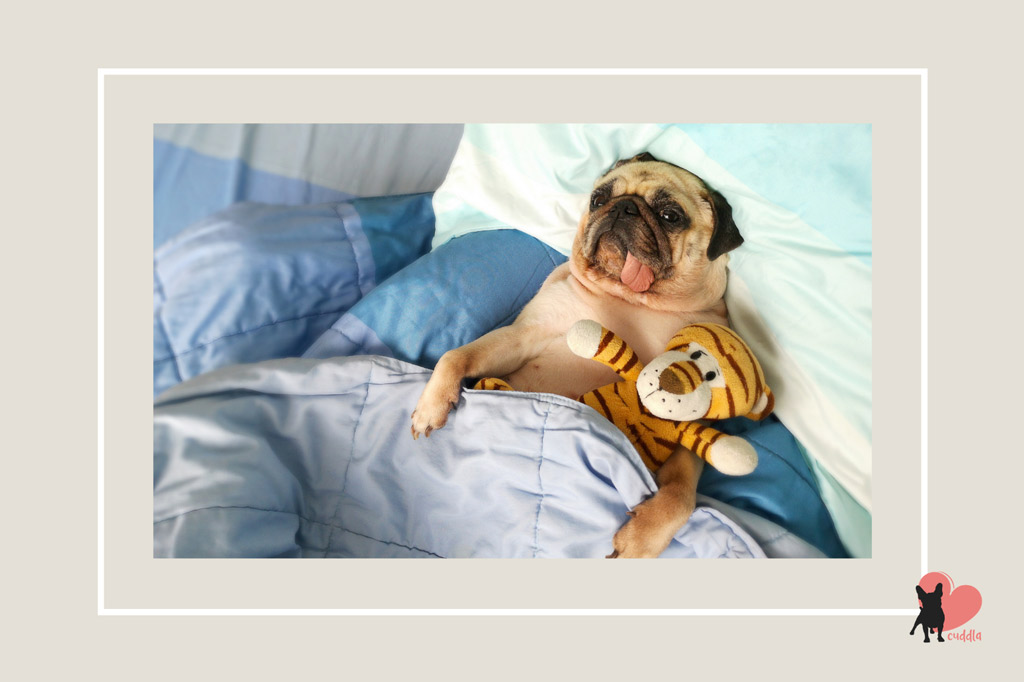
Pugs REM Sleep
Another difference between dogs and us is the REM (rapid eye movement) sleep, which is the restorative sleep.
Although we spend 25% of our sleep time in REM, dogs only spend 10%. As a result, it’s possible that dogs need to sleep more often to catch enough REM sleep.
Next time your Pug goes to sleep, pay attention to how:
- First, your dog will enter a slow wave of sleep in which their breathing rate slows, blood pressure drops and heart rate decreases.
- About 10 minutes in, your pooch enters the REM phase of sleep. Then, you can see twitching of the facial muscles and, as the name suggests, rapid movement of the eyes. This might happen whether your dog is dreaming or not.
- If your pooch is dreaming, you will notice her quivering, making leg twitches, whimpering or even growling when sleeping.
What Do Pugs Dream About?
What Pugs dream about is generally related to the activities that they engaged in during that day.
Matt Wilson, a neuroscientist who studies memory and learning at the Massachusetts Institute of Technology, conducted a study in dogs to find out what they dream about.
“Dreams are made from memories and experiences, but it’s not simply memory of an experience. They create new scenes built from old content that can be used to convey, emphasize, highlight or otherwise capture some kind of a meaningful point.”
Matt Wilson, a neuroscientist at the Massachusetts Institute of Technology.
Another interesting fact is that small dogs dream more than larger dogs.
The dog breed may also play a part in dreaming. For example, Labrador Retrievers (retrievers by nature and breeding) are more likely to dream about chasing a ball than a Pug would (bred as a company dog).
Dreaming also seems to occur more frequently in puppies, who do sleep more than adult dogs. This could also be because they are processing huge quantities of newly acquired experiences.
You have probably noticed your pooch quiver, make leg twitches, or even rapid movement of the eyes when sleeping. That’s a sign that your Pug is in REM sleep and possibly dreaming.
Whilst sleeping and/or dreaming, Pugs make a lot of funny noises. Which brings us to the next point… Pugs snore.
Pugs Snoring
Largely due to their short snouts, as a brachycephalic breed, Pugs frequently snore and snort during their sleep.
Snoring can get even louder if your Pug sleeps on her back – yeah, you read it right! Some Pugs sleep on their backs, with their tongues out! (Just look at the image below). 🙂
However, snoring is one of the most common signs of sleep apnea. This means that your dog will stop breathing for 10 to 20 seconds, repeatedly throughout her sleep.
While some dogs stay asleep, others will gasp and wake up. This can cause sleep deprivation to your Pug. i.e., your pooch might wake up cranky after her nap, just as you will if you didn’t get a good sleep.
So, if your Pug sounds like a tractor when she falls asleep, with some gasps in between, you might want to check with your vet to dismiss any health problems.
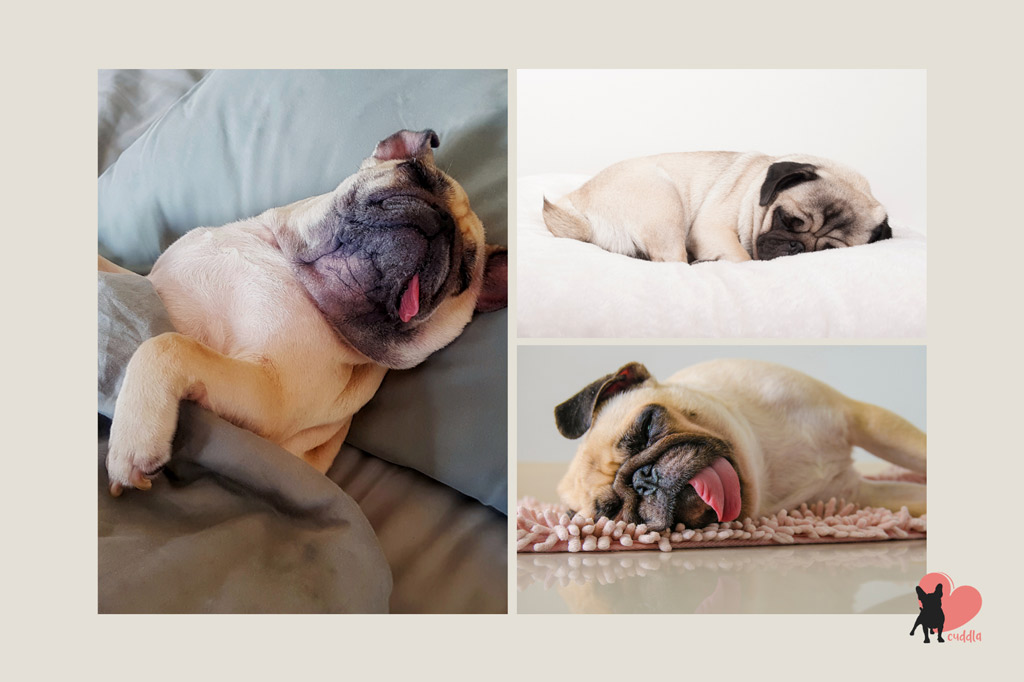
Why Does My Pug Sleep So Much?
If you’re concerned that your Pug sleeps a lot, here’s a clue:
Pugs can sleep more than average (12 to 14 hours a day) due to boredom, insufficient exercise, obesity, low-quality diet, the owner’s habits, illness or injury.
Excess sleep can also be a sign of potential problems like stress and separation anxiety can manifest as extra daytime snoozing.
If your pooch is ill or injured, she will sleep more than a healthy and fully mobile dog. But once she recovers, her sleep habits should go back to normal.
But if your Pug is bored because she’s not getting enough mental or physical stimulation, then you need to make sure she’s getting enough exercise. I will cover this in #2 – Activity Level section below.
So, how do I know if my Pug is sleeping too much?
Knowing your Pug’s normal sleeping patterns can be helpful. This knowledge will help you determine if your pooch is just tired or if her sleep has changed.
While there can be a lot of variability in Pugs sleeping habits, the one thing to keep an eye out for is a dramatic change.
So, if your Pug sleeps more than the average you’re used to and expect, take this matter to your vet for a better assessment.
Here are some signs that your Pug is sleeping too much:
- A change in your dog’s sleep patterns.
- A small change in your dog’s daily routine.
- Your dog prefers to sleep rather than play, eat, drink… basically your dog’s daily routine sequence gets altered or interrupted by sleep.
- It’s hard to wake up your dog in the morning.
- Your pooch falls asleep suddenly (narcolepsy).
- Etc.
Some of these signs might not be alarming or obvious if your Pug has always been a bit on the lazy side. However, it doesn’t hurt to ask your vet for a professional opinion.
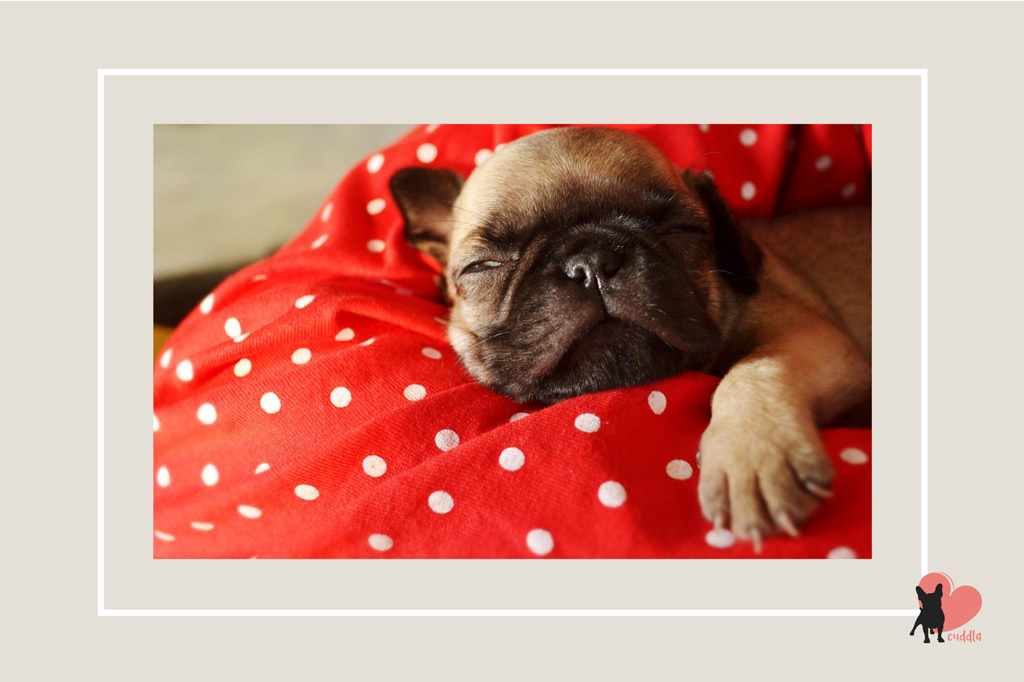
5 Factors Behind Pugs Sleeping Habits
These 5 factors are what can influence your Pug’s sleep.
#1 – Age
Age is one of the major factors that is used when giving an average of how much a dog sleeps per day.
How Long Do Pug Puppies Sleep?
Pug puppies need 18 to 20 hours of sleep per day. This includes nighttime and multiple naps, which usually last anywhere between ½ hour to 2 hours.
Despite being a ball of energy when they are awake, pups need a lot of sleep to grow and recharge their batteries.
Like human babies, your 8 weeks old Pug puppy will spend a lot of time sleeping when you get her home. But also like babies, very young puppies will not sleep through the night. This also has to do with their need to empty their bladder frequently.
Read also: When Are Pugs Full Grown? [Growth Chart Included].
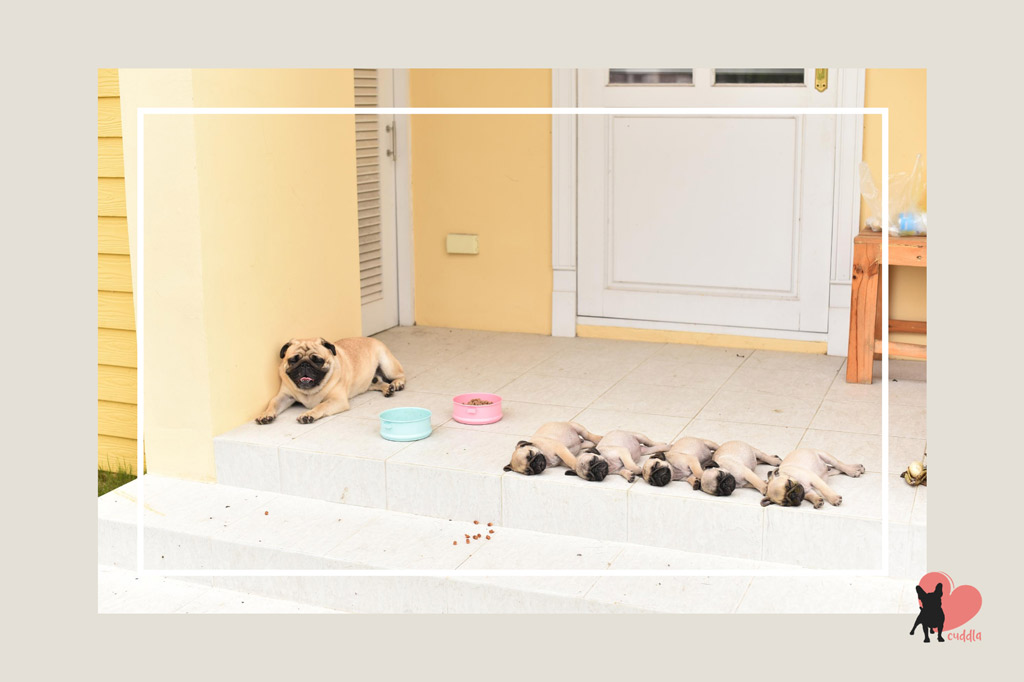
How Long Do Adult Pugs Sleep?
An adult Pug sleeps between 12 to 14 hours daily. An average family dog will spend about half their time (50%) napping, another 30% lounging around but awake, and the remaining 20% being active.
Since your pooch spends half of the day sleeping, it’s important that she has a good bed to sleep on. Use the guide in my favourite dog beds for features on the different types of dog beds.
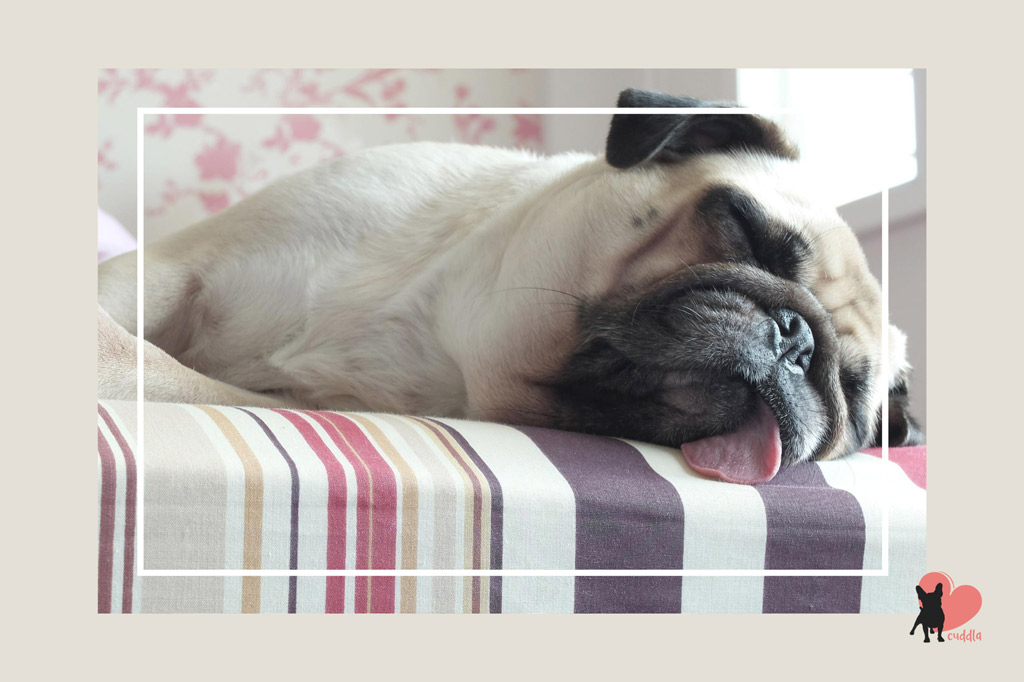
How Long Do Senior Pugs Sleep?
Senior Pugs can sleep around 18 to 20 hours a day. They tend to have lower energy levels, and like puppies, seniors need to recharge their batteries more often after exercise.
Your senior Pug is more likely to spend more time chilling and sleeping, especially if she has some health issues. Plus, age-related problems can come with a change in sleeping patterns.
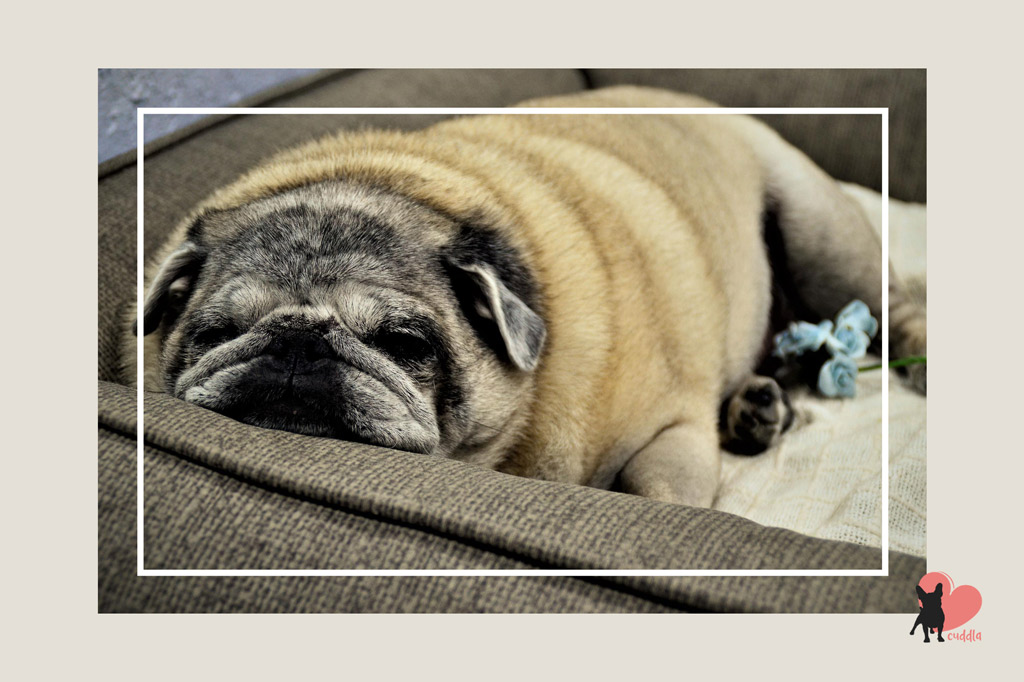
#2 – Activity Level
Active Pugs sleep less than inactive Pugs (a.k.a. couch potatoe doggies).
The main reason is they tend to have more energy and are doing things for a greater percentage of the day than inactive dogs are.
Remember that how active or lazy your Pug is depends on you. Your dog relies on you to exercise. If your Pug is used to two walks a day because you gradually took her out of the house since she was a puppy, she will thrive thanks to the activity.
Pugs need 30 minutes of exercise (like walking), plus playtime (like tug or retrieve games). They can be considered a less active breed compared to other brachycephalic small dogs like Boston Terriers.
Puppies and senior Pugs, however, have different needs. In How Much Exercise Does a Dog Need? and How Often Should I Walk My Dog? blog posts, you will find age-specific advice to exercise your Pug.
Read also: What Do Pugs Like to Play With? 10 Fun Pug Activities.
#3 – Diet
A low-quality diet will slow down your Pug in two ways:
- Since it doesn’t provide the essential nutrients, your pooch won’t be able to create the energy that they need to be active. This leads to a lethargic dog.
- Due to the number of filler ingredients they contain (rice, wheat, starches, etc.), your dog will have difficulty with digestion. As a result, your dog’s body will spend more energy digesting than playing.
P.S. A species-appropriate diet is a recommended way to ensure your pooch is getting all her nutrients in a healthy way. Head over to our Dog Nutrition guide for more.
Read also: Is My Pug Overweight? An Obesity Check & 8 Weight Loss Tips.
#4 – Breed Size
Big dogs are known to sleep more than small doggies, probably because large and giant breeds age quicker and have shorter lifespans.
Pugs fall into the small breeds category, so they should not be sleeping way more than their average for their age.
But, both small breeds and large breeds will spend as much as 18 hours a day sleeping if they have nothing better to do.
#5 – Lifestyle
What a dog has been bred to do has an influence on how much they sleep.
Working dogs like service, search, and rescue dogs, spend more time doing a job, and therefore they sleep less.
Pugs belong to the toy group and have been bred as companion dogs. Compared to working dogs, they fall at the other end of the snooze spectrum since they have no job to do. Some are known to excel in “sleep hours a day” contests.
So, as a family and companion dog, your Pug’s lifestyle totally depends on how active you are as an owner.
For instance, if your Pug is home alone during the day, she’s likely to sleep more (out of boredom).
As a Pug parent, you probably know that your pooch will happily just crash anywhere, and will hold awkward sleeping positions! You can probably relate to the photo below! 🙂
Our Tootsie would sleep between the chair legs to make sure she could put her face on our feet when we were at our home office.
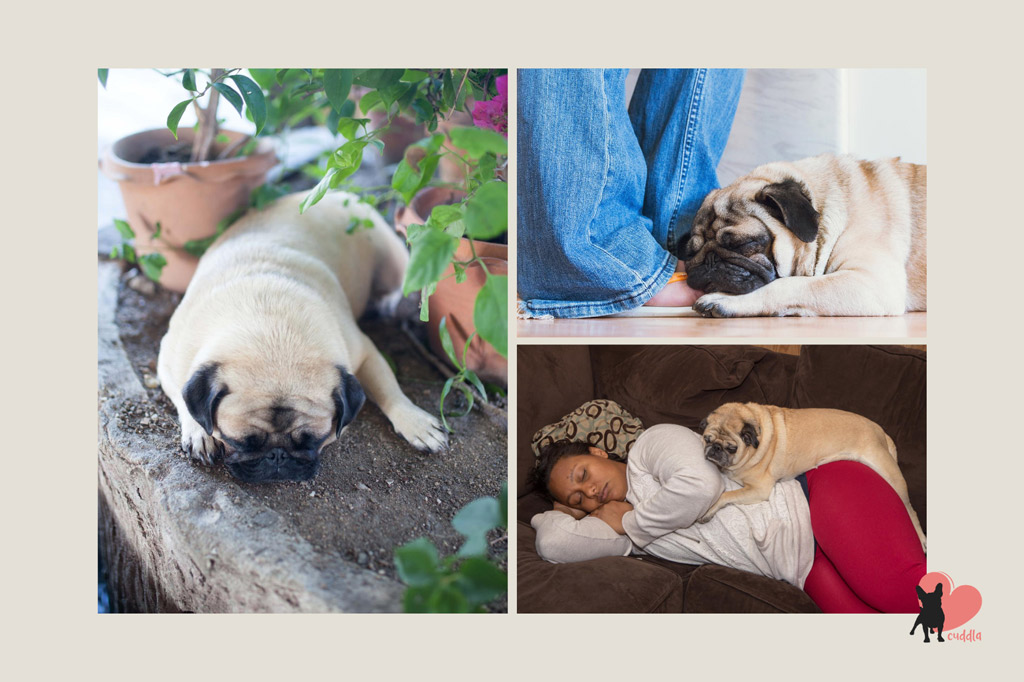
Pug Sleeping Companions
Where do Pugs sleep?
Everywhere! On their beds, the floor, on the sofa (including the sofa arm), on your bed (if you let them), on you (your lap, your feet)…
#1 – You and Your Kids
According to PetMd, it’s perfectly safe for your little companion to sleep in bed with you, as long as both of you are healthy.
It can even be beneficial. According to a new study from the Mayo Clinic, some dog owners find their pet’s presence soothing and helps them relax.
Some dog parents have even installed dog steps (view in Amazon) next to their beds so their Pugs can reach (some cannot jump that high) and sleep in their bed!
It’s up to you to decide if your Pug makes a good bed companion because they do snore and move around! As long as you are happy, healthy (both you and your dog) and not bothered by this.
#2 – Your Other Pets
Pugs don’t discriminate. They are friendly dogs that get along with other dogs and cats.
So, in a multiple pet household, you can expect your Pug to sleep next to, on top of, or under your other pet!
Pugs will bond not only to you and your children but to any other pets you might own.
Plus, Pugs love to snuggle.
There are three main reasons for your Pug to snuggle with you, your kids and other pets:
- Protection.
- Closeness.
- Warmth.
It’s in a dog’s nature to sleep on top of each other. From when they are pups, they snuggle close to each other to feel secure and comfortable. Which apart from the practicality, is also adorable!
#3 – Their Bed and Plush Toy
Since your Pug spends half of the day sleeping, it’s important that she has a good bed to sleep on. Use the guide in my favourite dog beds for features on the different types of dog beds.
Apart from a comfy bed, I always keep a blanket around for extra warmth and plush toy for extra comfort, especially when home alone (both found in Amazon).
#4 – The Outdoors
But, what if your Pugs enjoys chilling in the garden? Can Pugs sleep outside?
Pugs are meant to be kept indoors, especially during the night and when drastic temperature changes occur. Basically, Pugs should not be left outside unattended for long periods of time.
Because of being a brachycephalic breed, Pugs are extremely sensitive to cold temperatures, humidity, and heat. That’s why it’s dangerous to leave your dog outdoors unattended.
During the warm months, make sure that your Pug has enough shade and freshwater available. Here’s a great dog canopy (outdoors tent) to keep your Pug cool and under the shade whilst she’s chilling outdoors. 😉
